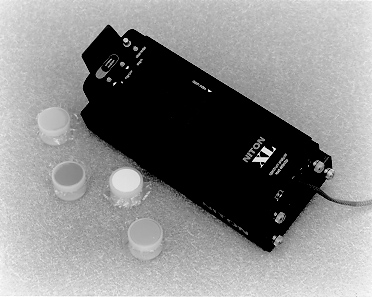
NITON Corporation (Niton) manufactures and services the XL Spectrum Analyzer, a hand-held, field portable X-ray fluorescence (FPXRF) instrument. The XL Spectrum Analyzer allows in situ and on-site measurement of select metals in paint films, soil, and other media. Niton originally designed the XL Spectrum Analyzer for fast, accurate, nondestructive measurement of lead in paint.
The XL Spectrum Analyzer includes a cadmium-109 radioactive source (10 millicurie) that provides the excitation energy which produces characteristic fluorescent X-rays from a sample. The instrument includes a silicon Pin-diode detector, cooled by the thermoelectric Peltier effect. The instrument also includes (1) a multichannel analyzer of 1,024 channels, (2) an RS-232 serial port for data transfer and printing, (3) an internal memory for storing up to 500 readings with spectra, and (4) a back-lit graphic liquid crystal display.
The instrument self-calibrates its energy scale and uses a Compton backscatter calibration technique. This calibration compensates for X-ray absorption in the soil matrix. The instrument is equipped with a removable battery pack that provides up to 8 hours of continuous use. It can analyze 200 to 300 samples in an 8- to 10-hour day, based on a 60-second analysis time and minimal sample preparation. The complete instrument, shown in the photograph below, weighs less than 3 pounds.

XL Spectrum Analyzer
Niton requires a 2-day operator training and radiation safety course, which is provided by Star Environmental Services at a cost of $350 per person. Niton manufactures the XL Spectrum Analyzer under a specific license with the State of Rhode Island. In general, an operator must be state licensed to possess and operate the instrument.
The standard XL Spectrum Analyzer costs $11,990, which includes the battery pack and charger, automotive power adapter, cable for serial data downloading, waterproof carrying case, operating and safety manual, paint film standards, barcode wand, personal computer software, and a 2-year warranty. The soil analysis application package costs an additional $6,000 and includes application software, sample collection and preparation equipment, accessories for measuring soil in place or in sample cups, soil standards, a user's manual, and a plastic carrying case. An extra battery pack costs $300. The cadmium-109 source, which has a half-life of 15 months, costs $2,200 to replace.
The XL Spectrum Analyzer can detect more than 15 elements in soil samples, such as those obtained from lead-contaminated residences, mining and smelting sites, drum recycling facilities, and plating facilities. The instrument can provide real-time, on-site analytical results during field screening and remediation operations. FPXRF analysis is faster and more cost-effective compared to conventional laboratory analysis.
The XL Spectrum Analyzer was demonstrated under the SITE Program in April 1995. The instrument was used to identify and quantify concentrations of metals in soils. A preliminary evaluation of the results yielded field-based method detection limits, accuracy, and precision data from the analysis of standard reference materials and performance evaluation samples. Comparability of the FPXRF results to an EPA-approved reference laboratory method was also assessed. An SW-846 method for FPXRF analysis of soils was published in 1996. A comprehensive evaluation of all results will be presented in a technical report from EPA in 1997.
EPA PROJECT MANAGER:
Stephen Billets
U.S. EPA
National Exposure Research Laboratory
Characterization Research Division
P.O. Box 93478
Las Vegas, NV 89193-3478
702-798-2232
Fax: 702-798-2261
TECHNOLOGY DEVELOPER CONTACT:
Stephen Shefsky
NITON Corporation
74 Loomis Street
P.O. Box 368
Bedford, MA 01730-0368
617-275-9275
Fax: 617-275-2397